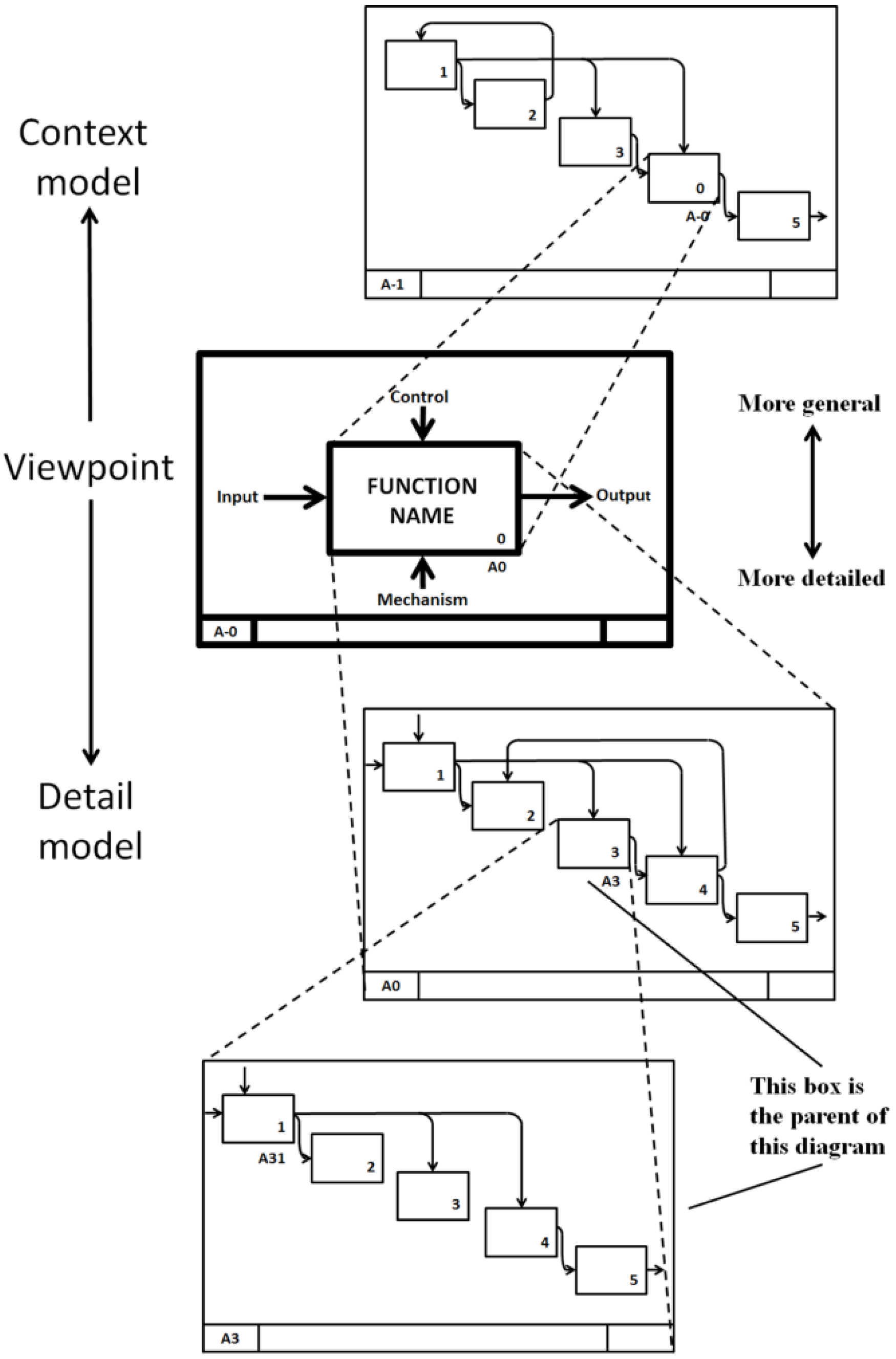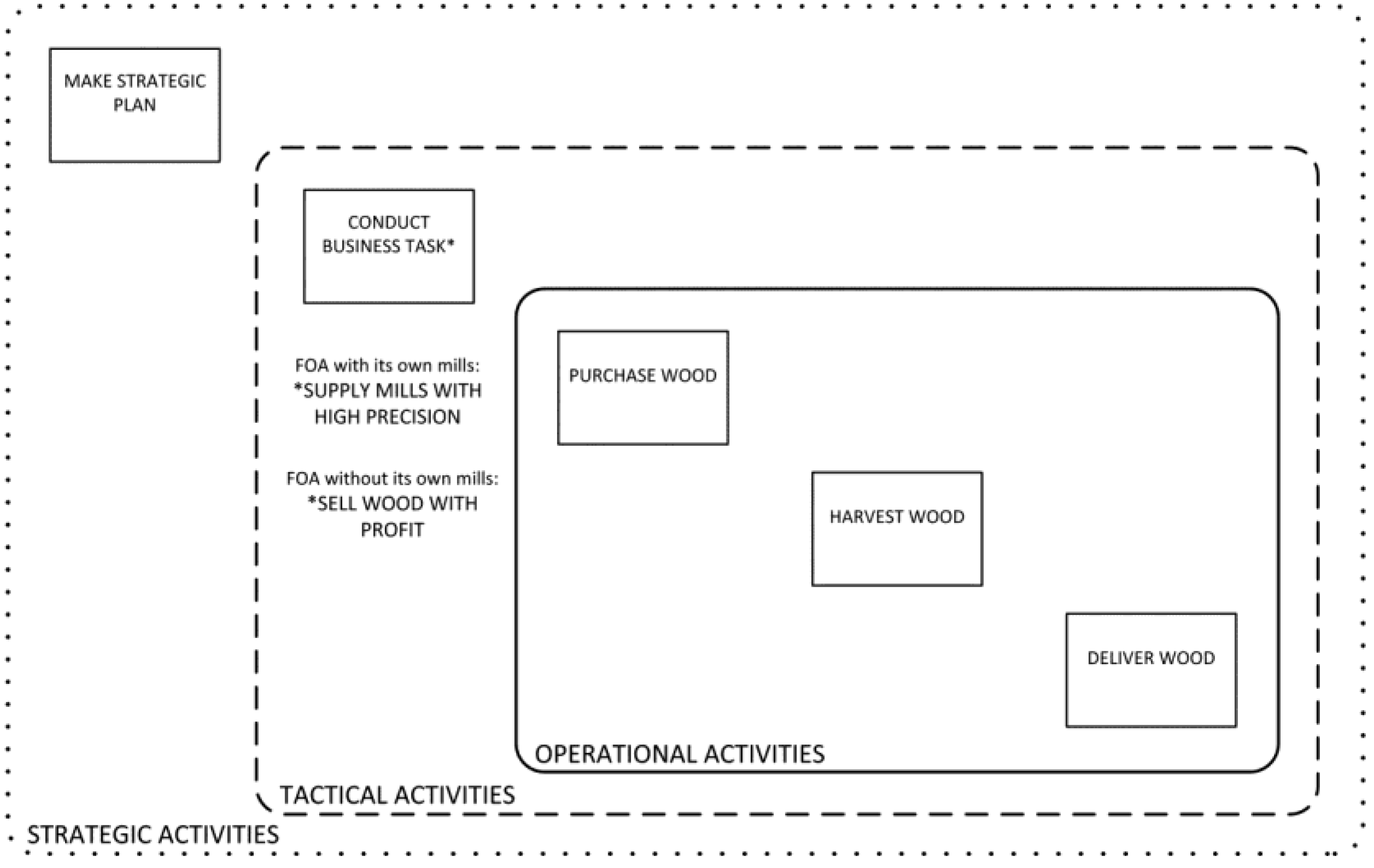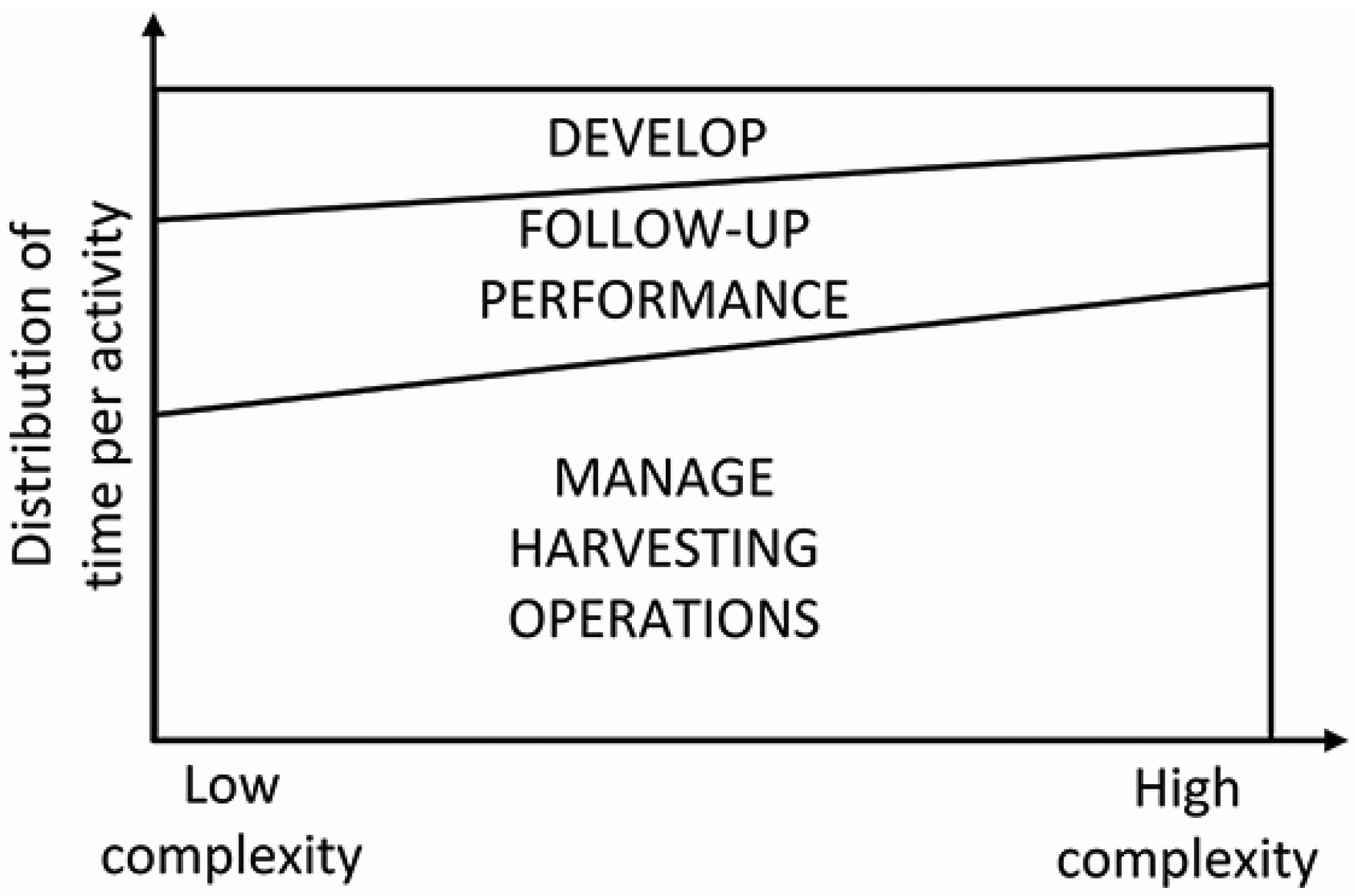The Impact of Industrial Context on Procurement, Management and Development of Harvesting Services: A Comparison of Two Swedish Forest Owners Associations
Abstract
:1. Introduction
1.1. Industrial Contexts for Operations Management

1.2. Outsourcing of Harvesting Services
1.2.1. Outsourcing Decisions
1.2.2. Outsourcing Design

1.3. Scope and Aim
2. Materials and Methods
2.1. Interviews
| FOA without its own mills | FOA with its own mills | Functions in focus | Number of respondents | ||||
|---|---|---|---|---|---|---|---|
| Region office 1 1 manager | Region office 2 1 manager | Head office 2 managers | Order/Purchase/Production | 4 | |||
| District 1 | District 2 | District 1 | District 2 | District 1 | District 2 | Purchase/Harvesting | 6 |
| Production manager | Production manager | Production manager | Production manager | Production manager | Production manager | ||
| Contractor | Contractor | Contractor | Contractor | Contractor | Contractor | Harvesting | 6 |
| Total number of respondents | 16 | ||||||
| Firm strategy | Supply strategies | Functions in focus for the interview | |
|---|---|---|---|
| Perspective | Processes and decisions | ||
| Business goals | Strategic perspective | To be discussed | Order/Purchase/Production |
| What? Why? | Long-term horizon | ||
| Organization | Tactical perspective | To be discussed | Order/Purchase/Harvesting |
| How to? | Medium-term horizon | ||
| Implementation | Operational perspective | To be discussed | Purchase/Harvesting |
| Doing it | Short-term horizon | ||
2.2. Function Modeling


2.3. Analysis
3. Results
3.1. The Context Models
3.1.1. A General Context Diagram

3.1.2. Strategic Activities
3.1.3. Tactical Activities

3.1.4. Operational Activities

3.1.5. Summary of Differences
| Perspective | Planning step | Frequency | FOA with its own mills | FOA without its own mills | ||
|---|---|---|---|---|---|---|
| Planning occurence & concern | Planning occurence & concern | |||||
| Supply | Demand | Supply | Demand | |||
| Strategic | Strategy | 5 years | X | X | ||
| Business plan (BP) | 3–5 years | X | X | X | X | |
| BP revision | 1 year | X | X | |||
| Tactical | Goal-based plan | 1 year | X | X | X | X |
| Demand-based plan | ½ year | X | X | |||
| Supply prognosis | 4 months | X | ||||
| Adjusted demand plan | 1–2 months | X | ||||
| Delivery plan | 1 month | X | X | X | X | |
| Operational | Adjustments | <1 month | X | X | ||
| Number of occurrences | 6 | 8 | 3 | 5 | ||
3.2. The Detailed Model
3.2.1. The Harvest Wood Function

3.2.2. The Adapt Harvesting Fleet Activity

3.2.3. The Develop Activity

3.2.4. The Manage Harvesting Operations Activity

3.2.5. Summary of Differences
| Activity | Sub-activity | Observed differences | |
|---|---|---|---|
| Between FOAs | Within FOAs | ||
| Prognsticate | Not detailed | ||
| Adapt harvesting fleet | Estimate need | 2 more controls (strategy & bi-monthly plan adjustments) in the FOA with its own mills | |
| Procure | Varying perceptions of contractor shortage, resulting in varying proportions of long-term contracts | ||
| Varying use of operations specific machinery | |||
| Follow-up performance | Varying descriptions of time spent on follow-up and development activities, depending on time required in operational management | ||
| Develop | Standardized protocol template for business development meetings in the FOA with its own mills | ||
| 1 more sub-activity (central compilation of development needs) in the FOA with its own mills | |||
| Follow-up outcome | Not detailed | ||
| Manage harvesting operations | Schedule | Contract price period was a control to the Schedule activity in the FOA without its own mills, as a consequence of the necessity to ensure a profit margin between price paid for wood and price received for mill deliveries | Variations in the balancing of consideration to internal efficiency needs versus contractors’ efficiency needs when scheduling harvesting operations |
| Order | Some productions managers gave no preliminary harvestings instructions to contractors, to avoid planning errors | ||
| Varying descriptions of re-planning needs, correspondingly influencing the possible time horizon to provide definite harvesting instructions | |||
| Some contractors communicated a need of timely instructions to enable proper preparatory planning | |||
| Supervise | Varying routines for production reporting | ||
4. Discussion
4.1. Contextual Differences

4.2. Procurement of Harvesting Services
4.3. Management of Harvesting Operations
4.4. Development of Harvesting Services

5. Conclusions
Acknowledgments
Conflicts of Interest
References
- NRA Sweden. A National Strategic Research Agenda (NRA) for the Forest-Based Sector in Sweden; The Swedish National Support Group: Stockholm, Sweden, 2006. [Google Scholar]
- Brunberg, T. Skogsbrukets kostnader och intäkter 2011 [Forestry Costs and Revenue 2011]; Skogforsk: Uppsala, Sweden, 2012. (in Swedish) [Google Scholar]
- Ager, B. Skogsarbetets rationalisering och humanisering 1900–2011 och framåt [The Rationalization and Humanization of Forest Work 1900–2011 and Forward]; Swedish University of Agricultural Sciences: Umeå, Sweden, 2012. (in Swedish). [Google Scholar]
- Nordfjell, T.; Bjorheden, R.; Thor, M.; Wästerlund, I. Changes in technical performance, mechanical availability and prices of machines used in forest operations in Sweden from 1985 to 2010. Scand. J. Forest Res. 2010, 25, 382–389. [Google Scholar] [CrossRef]
- Högnäs, T. Towards Supplier Partnerships in Timber Harvesting and Transportation; Metsähallitus: Vantaa, Finland, 2000. [Google Scholar]
- Hultåker, O. Entreprenörskap i skogsdrivningsbranschen: En kvalitativ studie om utveckling i små företag [Entrepreneurship in the forest harvesting industry: A qualitative study of development in small enterprises]. Ph.D. Thesis, Swedish University of Agricultural Sciences, Uppsala, Sweden, 2006. [Google Scholar]
- Berlin, C. Forest Owner Characteristics and Implications for the Forest Owner Cooperative. Licentiate Thesis, Swedish University of Agricultural Sciences, Umeå, Sweden, 2006. [Google Scholar]
- Swedish Forest Agency. Swedish Statistical Yearbook of Forestry 2012; Swedish Forest Agency: Jönköping, Sweden, 2013.
- Nollet, J.; Ponce, S.; Campbell, M. About “strategy” and “strategies” in supply management. J. Purch. Supply Manage. 2005, 11, 129–140. [Google Scholar] [CrossRef]
- Lapierre, J. Customer-perceived value in industrial contexts. J. Bus. Ind. Marketing. 2000, 15, 122–140. [Google Scholar] [CrossRef]
- Teece, D.J. Strategies for managing knowledge assets: The role of firm structure and industrial context. Long Range Plann. 2000, 33, 35–54. [Google Scholar] [CrossRef]
- Häggström, C.; Kawasaki, A.; Lidestav, G. Profiles of forestry contractors and development of the forestry-contracting sector in Sweden. Scand. J. Forest Res. 2013, 28, 395–404. [Google Scholar] [CrossRef]
- Norin, K. Upphandling och försäljning av entreprenadtjänster i skogsbruket-en diskussion om affärskoncept som stöder drivningssystemens utveckling [Forestry-Contractor Services-Buying and Selling: A Discussion of Business Approaches that Support Developments in Logging Systems]; Skogforsk: Uppsala, Sweden, 2002. (in Swedish) [Google Scholar]
- Bergquist, E. Varför Lämnar Skogsmaskinförare Branschen? [Why do Forest Machine Operators Leave the Forest Industry?]; Swedish University of Agricultural Sciences: Umeå, Sweden, 2009. (in Swedish) [Google Scholar]
- Rummukainen, A.; Dahlin, B.; Penttinen, M.; Selby, A.; Mikkola, J. Challenges to the forest machine business as a result of global economic change. In Forest, Wildlife and Wood Sciences for Society Development, Proceedings of the IUFRO Conference, Prague, Czech Republic, 16–18 April 2009.
- Penttinen, M.; Rummukainen, A.; Mikkola, J. Profitability, liquidity and solvency of wood harvesting contractors in Finland. Small Scale For. 2011, 10, 211–229. [Google Scholar] [CrossRef]
- Vining, A.; Globerman, S. A conceptual framework for understanding the outsourcing decision. Eur. Manage. J. 1999, 17, 645–654. [Google Scholar] [CrossRef]
- Arnold, U. New dimensions of outsourcing: A combination of transaction cost economics and the core competencies concept. Eur. J. Purch. Supply Manage. 2000, 6, 23–29. [Google Scholar] [CrossRef]
- Quélin, B.; Duhamel, F. Bringing together strategic outsourcing and corporate strategy: outsourcing motives and risks. Eur. Manage. J. 2003, 21, 647–661. [Google Scholar] [CrossRef]
- Quinn, J.B.; Hilmer, F.G. Strategic outsourcing. Sloan Manage. Rev. 1994, 36, 45–55. [Google Scholar]
- Cousins, P.D. The alignment of approriate firm and supply strategies for competitive advantage. Int. J. Oper. Prod. Man. 2005, 25, 403–428. [Google Scholar] [CrossRef]
- Carlsson, D.; Rönnqvist, M. Supply chain management in forestry—Case studies at Södra Cell AB. Eur. J. Oper. Res. 2005, 163, 589–616. [Google Scholar] [CrossRef]
- Uusitalo, J. A framework for CTL method-based wood procurement logistics. Int. J. For. Eng. 2005, 16, 37–46. [Google Scholar]
- Audy, J.-F.; Pinotti Moreira, M.; Westlund, K.; D’Amours, S.; LeBel, L.; Rönnqvist, M. Alternative Logistics Concepts Fitting Different Wood Supply Situations and Markets; Interuniversity Research Centre: Québec City, Canada, 2012. [Google Scholar]
- Tap, S.D.; Ganesan, S. Control mechanisms and the relationship life cycle: Implications for safeguarding specific investments and developing commitment. J. Marketing Res. 2000, 37, 227–245. [Google Scholar] [CrossRef]
- Furness-Lindén, A. Affärsutveckling i relationen stor kund/liten leverantör—Vad kan skogsbruket lära? [Business Development: Large Customer-Small Supplier Relations. What Can Forestry Learn from the Process?]; Skogforsk: Uppsala, Sweden, 2008. (in Swedish) [Google Scholar]
- Norin, K.; Furness-Lindén, A. Vägar till professionell upphandling av tjänster i skogsbruket—Erfarenheter, förslag och inspirationskälla [Ways to Improve the Procurement of Services in Forestry—Experience, Recommendations and Inspiration]; Skogforsk: Uppsala, Sweden, 2008. (in Swedish) [Google Scholar]
- Robins Sadler, G.; Lee, H.-C.; Hwan-Lim, R.S.; Fullerton, J. Recruitment of hard-to-reach population subgroups via adaptions of the snowball sampling strategy. Nurs. Health Sci. 2010, 12, 369–374. [Google Scholar] [CrossRef]
- National Institute of Standards and Technology (NIST). Integration Definition for Function Modeling (IDEF0); National Institute of Standards and Technology: Gaithersburg, MD, USA, 1993.
- Noran, O.S. Business Modelling: UML vs. IDEF; Griffith University: Nathan, Australia, 2000. [Google Scholar]
- Cascini, G.; Rissone, P.; Rotini, F. Business re-engineering through integration of methods and tools for process innovation. Proc. Inst. Mechanical Eng. Part. B: J. Eng. Manuf. 2008, 222, 1715–1728. [Google Scholar] [CrossRef]
- Haapaniemi, M. En generell processkartläggning av leveransplanering för biobränsle i Sverige [A Generic Process Model for Delivery Scheduling of Biofuels in Sweden]; Swedish University of Agricultural Sciences: Umeå, Sweden, 2011. (in Swedish) [Google Scholar]
- Carlsson, D.; D’Amours, S.; Martel, A.; Rönnqvist, M. Supply chain planning models in the pulp and paper industry. Inf. Syst. Oper. Res. 2009, 47, 167–183. [Google Scholar]
- Andrén, M.; Fjeld, D. Information flow model for Swedish pulp wood supply. In Silva Carelica, Proceedings of the NSR Conference on Forest OperationsHyytiälä Forest Field Station, Hyytiälä, Finland, 30–31 August 2004; Volume 45, pp. 150–158.
- Kollberg, M. Beyond IT and Productivity—Effects of Digitized Information Flows in the Logging Industry. Licentiate Thesis, Linköping University, Linköping, Sweden, 2005. [Google Scholar]
- Brunberg, T.; Lundström, H. Rätt maskinval i gallring—Studie vid SCA skog [Smallest Harvester Cost-Effective in Small-Diameter Thinnings; Medium-Duty Harvester Best in Somewhat Larger Stands]; Skogforsk: Uppsala, Sweden, 2010. (in Swedish) [Google Scholar]
- D’Amours, S.; Rönnqvist, M.; Weintraub, A. Using operational research for supply chain planning in the forest products industry. Inf. Syst. Oper. Res. 2008, 46, 265–281. [Google Scholar]
- Bergkvist, I. Tvåskift är billigast, men låga räntor minskar gapet mot enkelskift [Two-Shift System Cheapest but Low Interest Rates are Closing the Single-Shift Gap]; Skogforsk: Uppsala, Sweden, 2010. (in Swedish) [Google Scholar]
- Norin, K.; Karlsson, A. Så arbetar en vinnare—Djupintervjuer med tio lönsamma skogsentreprenörer [What Makes a Winner? —Searching Interviews with 10 Successful Forestry Contractor Businesses]; Skogforsk: Uppsala, Sweden, 2010. (in Swedish) [Google Scholar]
- Vestling, B. Kostnadspåverkande faktorer för skördare—En analys av uppföljningsdata hos Stora Enso Skog [Factors Influencing Costs for Harvesters—An Analysis of Follow-Up Data at Stora Enso Skog]; Swedish University of Agricultural Sciences: Umeå, Sweden, 2012. (in Swedish) [Google Scholar]
- Mayo, J.H.; Greene, W.D.; Clutter, M.L.; deHoop, N.; Egan, A.F. Causes and Costs of Unused Logging Production Capacity. In A Global Perspective, Proceedings of the Council on Forest Engineering (COFE) Conference, Auburn University, Auburn, AL, USA, 16–20 June 2002.
- Spinelli, R.; Visser, R. Analyzing and estimating delays in harvester operations. Int. J. For. Eng. 2008, 19, 36–41. [Google Scholar]
- Mörk, A.; Thorsén, T. Nyckelfaktorer för effektiva maskinlag [Key Factors for Improving Efficiency of Logging Teams]; Skogforsk: Uppsala, Sweden, 2011. (in Swedish) [Google Scholar]
- Arlinger, J.; Möller, J. Standard för Skotarrapportering—Viktig Länk i Skogsbrukets Logistik [New Standard for Forwarder Reports—A Vital Link in Forestry Logistics]; Skogforsk: Uppsala, Sweden, 2006. (in Swedish) [Google Scholar]
- Arlinger, J. Nya möjligheter med StanForD 2010 [Updated Standard for Forest Machine Data-StanForD 2010]; Skogforsk: Uppsala, Sweden, 2011. (in Swedish) [Google Scholar]
- Bjerner, J. Betydelsen av felaktig information i traktbanken—Inverkan på virkesleveranser samt tidsåtgång och kostnad vid avverkningar [The Consequences of Erroneous Information in Stand Registers—Its Effect on Timber Delivieries and Harvesting Operations]; Swedish University of Agricultural Sciences: Umeå, Sweden, 2004. (in Swedish) [Google Scholar]
- Hultén, L.; Bolin, H. Information Exchange and Controllability in Logistics; Transport Research Institute: Stockholm, Sweden, 2002. [Google Scholar]
© 2013 by the authors; licensee MDPI, Basel, Switzerland. This article is an open access article distributed under the terms and conditions of the Creative Commons Attribution license (http://creativecommons.org/licenses/by/3.0/).
Share and Cite
Erlandsson, E. The Impact of Industrial Context on Procurement, Management and Development of Harvesting Services: A Comparison of Two Swedish Forest Owners Associations. Forests 2013, 4, 1171-1198. https://doi.org/10.3390/f4041171
Erlandsson E. The Impact of Industrial Context on Procurement, Management and Development of Harvesting Services: A Comparison of Two Swedish Forest Owners Associations. Forests. 2013; 4(4):1171-1198. https://doi.org/10.3390/f4041171
Chicago/Turabian StyleErlandsson, Emanuel. 2013. "The Impact of Industrial Context on Procurement, Management and Development of Harvesting Services: A Comparison of Two Swedish Forest Owners Associations" Forests 4, no. 4: 1171-1198. https://doi.org/10.3390/f4041171




